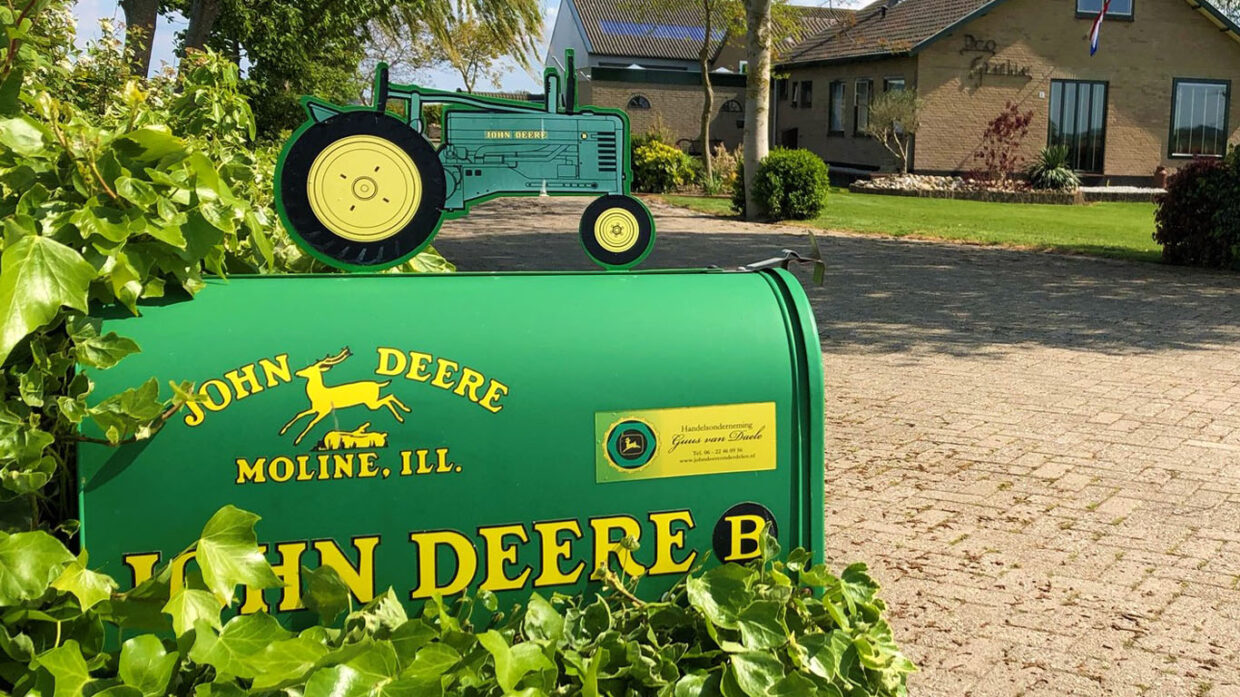At the Van Daeles’ set-up in the Dutch town of Dronten, John Deere is all around. When you drive into the courtyard, the first thing you’ll spot is a green and yellow American letterbox. Behind the house is a barn with the logo riveted to the outside wall, and inside you will find a separate room dedicated to green-yellow collector items.
The eye-catcher in the barn, which has been converted into a cosy ‘Bruin Café’, is a John Deere B from 1938. Father and son team, Guus and Stanny van Daele, came across the tractor by chance. “A trader put up a John Deere R for sale,” says Guus. “We had agreed on a price when it turned out that he had already sold the R to another interested party. Then he suddenly came up with this John Deere B at a price we couldn’t refuse. We overhauled the tractor ourselves. Now it’s a beautiful little old tractor.”
Decades of John Deere
The pair’s passion for John Deere began in 1984, says Guus. “I worked at a dealer which was acquired by John Deere’s former importer Louis Nagel. After that, I switched to another dealer, who then also became a John Deere distributor. Somehow, I just couldn’t escape it, I guess,” he laughs. “If you work there every day, you can’t help but automatically get excited.”
His son also got swept up in his passion. Stanny sits at the table in a John Deere T-shirt. “It’s a true global brand,” he says. His mother shows off a picture of three-year-old Stanny on a green-yellow toy tractor. “All his nursery school projects were green and yellow,” she recalls. “He grew up with it.”
The start of a new business venture
The collecting of green and yellow parts reached a whole new level when a John Deere distributor closed his business in Schildwolde in 2003. Guus immediately seized the opportunity to get his hands on all of their entire basic stock. “I always wanted to run my own business – and this was just the right moment. We were able to set up a small business. I had already noticed at work that there was a constant demand for older parts. But starting a business without basic stock available would have been difficult. So this was our chance.”
He started selling parts through the Marktplaats online portal, but soon built his own website. After completing his agricultural studies, his son knew he wanted to continue working in this world, in addition to working on the land during the busy spring and autumn seasons.
Fast-growing trade for old parts
Together, they started small and gradually became more and more successful. In 2012, they moved their stock from the barn behind the house to a larger shed on a nearby industrial estate. And they are already planning their move to another building. “We browse internet sites and auctions at home and abroad in search of unique parts. We are particularly interested in the older parts,” says Guus. “This is firstly so as not to get in the way of the local dealers. A dealer will only get in touch with us if they get stuck.”
“We don’t want to get in the way of the local dealers. A dealer will only get in touch with us if they get stuck.”
Guus van Daele
He also points out that there is a good market for older parts abroad. “In other countries, tractors are generally used for longer than here, so the demand for parts is higher. And we also don’t have that many hobby drivers here any more either,” he adds. “People now want their tractor to be ready so they can drive off in it immediately. They no longer feel like tinkering with it themselves. And in addition, labour in the Netherlands is expensive, so people generally don’t tinker as much here any more. This is different in countries like Poland. As a result, we export a lot to former Eastern Bloc and African countries.”
About 20% of their inventory doesn’t spend much time in storage. This includes engines, chassis, lighting equipment and hydraulic systems. The remaining 80% has a longer stay. This mainly includes hoods, end drives and models which are less popular in the Netherlands, like the 5000 series and fruit-growing tractors.

Getting old tractors back up and running is one of Guus and Stanny van Daele’s hobbies.
Searching for gems
“It’s not just the trade, but also the tinkering that makes this business so interesting,” says Stanny. “The combination of the two is what makes it fun. The things we do are quite diverse: Trading, tinkering, exporting, and tracking down parts.” And in some of their research, they come across real gems. For example, they found three tractors on an estate in Hilversum which had been standing still for five years, overgrown with moss. “The beauty of it is that we got them back up and running within a day. That’s perhaps the best thing about this job: Getting old John Deere tractors working again. Sustainable recycling, so to speak.”






